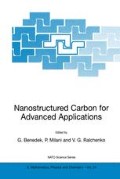Abstract
We present recent density-functional based investigations on functionalization of carbon nanotubes (CNT’s). Potential problems and applications that will be addressed include: (i) Chemical force imaging by interaction of open-end functionalized CNT’s with self-assembled monolayers; (ii) Tailoring of intrinsic electronic properties for nanoscale electronics by side-wall functionalization of CNT’s with fluorine; and (iii) Electrochemically based mechanisms for hydrogen storage.
Access this chapter
Tax calculation will be finalised at checkout
Purchases are for personal use only
Preview
Unable to display preview. Download preview PDF.
References
Kroto H.W., Heath J.R., O’Brien S.C., Curl R.F. and Smalley R.E. (1985) Nature (London) 318, 162.
Iijima S. (1991) Nature (London) 354, 56.
Wong S.S., Joselevich E., Wooley A.T., Cheung C.L. and Lieber CM. (1998) Nature (London) 394, 52; Liu J., Rinzler A.G., Dai H., Hafner J., Bradley R.K., Boul P., Lu A., Iverson T., Shelimov K., Huffman C.B., Rodriguez-Macias F., Shon Y.S., Lee T.R., Colbert D.T. and Smalley R.E. (1998) Science 280, 1253.
Wong S.S., Joselevich E., Woolley A.T., Cheung C.L., and Lieber C.M. (1998) Nature 394, 52.
Dai H., Hafner J.H., Rinzler A.G., Colbert D.T., and Smalley R.E. (1996) Nature 384, 147.
Keller D. (1996) Nature 384, 111.
Park I., Elstner M., Frauenheim T., Kaxiras E. (2000) Chem. Phys. Lett. submitted.
Mickelson E.T., Huffman C.B., Rinzler A.G., Smalley R.E., Hauge R.H. and Margrave J.L. (1998) Chem. Phys. Lett. 296, 188.
Mickelson E.T., Chiang I.W., Zimmerman J.L., Boul P.J., Lozano J., Liu J., Smalley R.E., Hauge R.H. and Margrave J.L. (1999) J. Phys. Chem. B103, 4318.
Kelly K.F., Chiang I.W., Mickelson E.T., Hauge R.H., Margrave J.L., Wang X., Scuseria G.E., Radloff C. and Halas N.J. (1999) Chem. Phys. Lett 313, 445.
A. C. Dillon et al., Nature 386, 377 (1997).
Y. Ye et al., Appl. Phys. Lett. 74, 2307 (1999).
C. Liu et al., Science 286, 1127 (1999).
A. Chambers et al., J. Phys. Chem. 102, 4253 (1998).
C. Nutzenadel et al., Electrochem. and Solid-State Lett. 2, 30 (1999).
S. M. Lee et al., accepted to Syn. Metals.
M. Elstner et al., Phys. Rev. B 58, 7260 (1998).
DMol3 is a registered software product of Molecular Simulations Inc.; B. Delley, J. Chem. Phys. 92, 508 (1990).
The convergency criterion for the structure optimization is that all forces be ≤ 0.001 a.u.. and the energy change for the charge density per self-iteration be ≤ 1.0x10-5 atomic units. Structure optimization is done by the SCC-DFTB and LDA schemes. The GGA calculations are done with structures optimized by LDA whenever necessary.
Shirakawa H. and Ikeda S. (1971) Polym. J. 2, 231.
Naarmann H. and N. Theophiliou N. (1987) Synth. Met. 22, 1.
Piao G., Kaneko S., Higuchi I., Akagi K., Shirakawa H. and Kyotani M. (1999) Synth. Met. 101, 94.
The binding energy of C-H bond is calculated by, Eb(C-H) = Etotal(CNT+H) — Etotal(CNT) — NH Eatom (H).
The binding energy is overestimated by 0.9 eV in the SCC-DFTB, compared to the GGA calculations. However the energy differences for different configurations were small.
S. M. Lee and Y. H. Lee, accepted to Appl. Phys. Lett.
M. R. Pederson and J. Q. Broughton, Phys. Rev. Lett. 69, 2689 (1992).
P. M. Ajayan and S. Iijima, Nature 361, 333 (1993).
We move an hydrogen atom towards the tube wall in each step and then fix the radial component of the hydrogen atom, while relaxing all other carbon atoms in the tube. This relaxation scheme is applied to the rest of the calculations, unless specified.
We have also tried several flip-in processes, where the hydrogen atom rotates through the hexagonal ring. However, rotation of hydrogen atom to near the graphitic plane induces severe distortions of sp 3 bonds, resulting in the formation of a new CH2 at the adjacent carbon site and the bond-breaking of the C-C bond. This gives rise to a large activation barrier ≥ 3 eV and furthermore disintegrates the tube wall.
S. M. Lee et al., unpublished.
The maximum hydrogen coverage can be reached when the CNT-call forms an arch type with molecular hydrogens inside the capillary.
Author information
Authors and Affiliations
Editor information
Editors and Affiliations
Rights and permissions
Copyright information
© 2001 Springer Science+Business Media Dordrecht
About this paper
Cite this paper
Frauenheim, T., Seifert, G., Koehler, T., Elstner, M., Lee, S.M., Lee, Y.H. (2001). A Theoretical Approach to Functionalization of Carbon Nanotubes. In: Benedek, G., Milani, P., Ralchenko, V.G. (eds) Nanostructured Carbon for Advanced Applications. NATO Science Series, vol 24. Springer, Dordrecht. https://doi.org/10.1007/978-94-010-0858-7_18
Download citation
DOI: https://doi.org/10.1007/978-94-010-0858-7_18
Publisher Name: Springer, Dordrecht
Print ISBN: 978-0-7923-7042-0
Online ISBN: 978-94-010-0858-7
eBook Packages: Springer Book Archive

